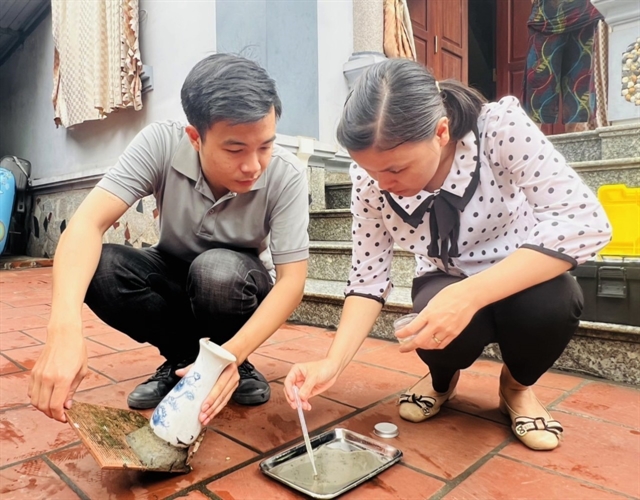 Society
Society


|
| Medical workers take samples to define mosquitos causing dengue fever in Bình Định Commune, Lương Tài District, Bắc Ninh Province. — VNA/VNS Photo Thanh Thương |
HÀ NỘI — Việt Nam is currently undergoing a transition period from summer to autumn, a time that can cause the spread of diseases in many localities across the country.
Provinces and cities are striving to control the seasonal diseases, including digestive, respiratory, hand-foot-mouth disease, pink eye (conjunctivitis) and dengue fever.
Dengue fever
From the beginning of the year, the country has recorded 81,808 cases of dengue fever with 23 deaths.
Compared to the same period last year, which saw 203,709 cases and 107 deaths, the number of cases decreased by 59.8 per cent and the deaths decreased by 84 cases.
However, last week, the country had 5,180 cases of dengue fever and one death in Hòa Bình Province. An increase by 0.5 per cent compared to the previous week.
In Gia Lai Central Highlands province, the provincial Centre for Disease Control (CDC) said as the current rainy season in the area is a favourable condition for dengue fever development.
The epidemic situation in the province is complicated, with most cases concentrated in the districts of Đức Cơ (598 cases), Chư Prông (440 cases), Krông Pa (353 cases), and in Pleiku City (346 cases).
The disease has been seen in 186 out of 220 communes, wards and towns of all 17 districts.
The province now has 174 dengue fever outbreaks that have not been controlled.
Sóc Trăng southern province has had 2,688 cases of dengue fever so far this year, an increase of 1,326 cases compared to 2022, including 112 severe cases.
It has more than 1,150 disease outbreaks, which were already controlled according to regulations.
The Hà Nội CDC said that last week, the city recorded 2,010 cases of dengue fever in 29 districts, double the number compared to the previous week.
Districts with many patients are Phú Xuyên (163), Hoàng Mai (136), Cầu Giấy (134), Hà Đông (132), Đống Đa (125), Đan Phượng (122), Thanh Oai (119) and Thanh Trì (104).
The capital city has had 10,372 cases of dengue fever so far this year and three deaths. Compared to the same period last year, the number of cases increased nearly four times although fatalities stayed the same.
The Ministry of Health has assigned experts from the National Institute of Hygiene and Epidemiology to support Hà Nội in professional work to control the disease.
Pink eye

|
| A doctor examines a student with conjunctivitis in Tây Ninh Province. — VNA/VNS Photo Minh Phú |
Just last Saturday, Đắk Lắk recorded 2,947 cases of pink eye, including 2,781 cases in schools, accounting for 94.3 per cent.
Đỗ Tường Hiệp, deputy director of the provincial Department of Education and Training, said that the department had sent a letter to schools on strengthening measures to prevent the disease.
The Hoa Lan Kindergarten in Buôn Ma Thuột City has about 200 children in 10 classes. About a month ago, the school only had some children with pink eye but since the beginning of the new school year, the number of children infected increased rapidly.
Lê Thị Liên, principal of the kindergarten, said that the school's management board coordinated with the medical staff to implement preventive and control measures.
Hygiene was always the school's top priority, she said.
Hoàng Hải Phúc, deputy director of the Đắk Lắk CDC, said that to effectively prevent and control pink eye infections, CDC recommended districts, towns and cities to strengthen monitoring, early detection and timely handling of outbreaks in the area.
Localities should conduct anti-infection measures at kindergartens, schools, agencies, factories and in the community.
Medical staff must organise consultations and treatment, and strengthen infection control at treatment facilities based on the Ministry of Health’s regulations.
Tây Ninh southern province has seen more than 140 adults and more than 6,200 students at all levels of education with pink eye so far this month.
The provincial Department of Health and Department of Education and Training sent an official dispatch requesting heads of organisations and schools to implement urgent preventive and control measures.
Nguyễn Thị Hường, principal of the Tuổi Ngọc Kindergarten in Tây Ninh City, said that the school had given parents methods to prevent pink eye, kept hygiene for the environment, classrooms and common areas for children with antiseptic solution, and regularly washed children's hands with soap.
Deputy head of the Tây Ninh Department of Education and Training Lưu Thị Thu said that to date, the province has seen infections in 26 out of 48 schools.
Huỳnh Văn Quới, a medical worker of the Tây Ninh City Medical Centre, said that in response to the complicated epidemic situation in schools, the local health and education sectors urgently established inspection groups.
The groups guide and support schools to control the epidemic, checked classroom hygiene, waste treatment, food hygiene and safety in the kitchens of boarding schools, and disinfection in restrooms and common areas.
The pink eye situation also rose in Vinh City and in Nghệ An central province during the past month.
The Nghệ An Obstetrics and Paediatrics Hospital receives about 30-40 children for pink eye checks per day.
Doctor Phạm Thị Vân, deputy head of the Eye Ward under the hospital, said that they have treated for more than 1,000 children in the past month.
Many of them are of kindergarten age.
The majority of children come to the hospital for examination early, so the treatment process was safe and effective.
However, a small number of children have complications in the cornea because their parents arbitrarily bought medicines incorrectly, making the treatment process difficult, taking a long time to heal, and possibly leaving negative consequences that impair vision, Vân said.
Hand-foot-mouth disease
An Giang Province has seen more than 2,800 hand-foot-mouth cases so far this year, an increase of 16 per cent compared to the same period last year.
Chợ Mới District has the highest number in the province with 781, followed by Thoại Sơn and Châu Thành districts.
The province had two deaths, double the same period last year.
The local education sector strongly implements activities to prevent and control the disease. Kindergartens must have hand washing facilities and soap for caregivers and children.
It must also carry out classroom cleaning and environmental sanitation as well as strengthen inspections at kindergartens and care centres for children under the age of five. — VNS




